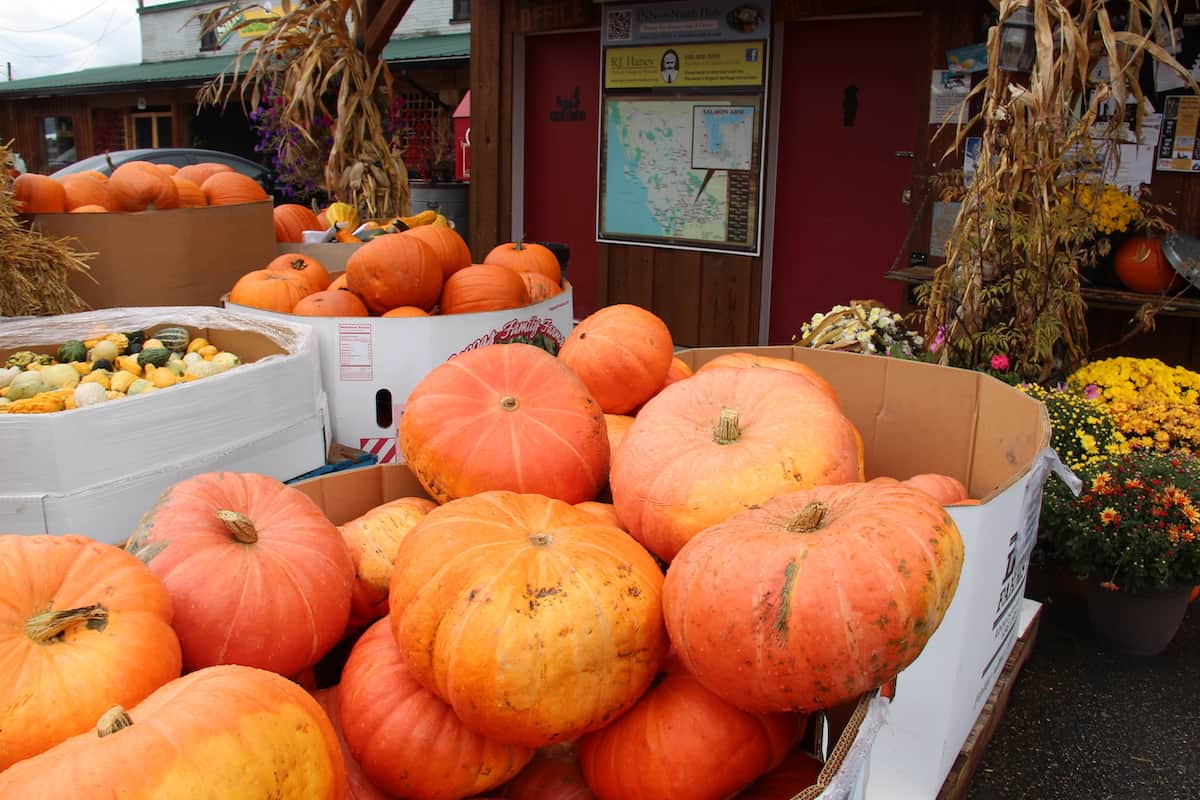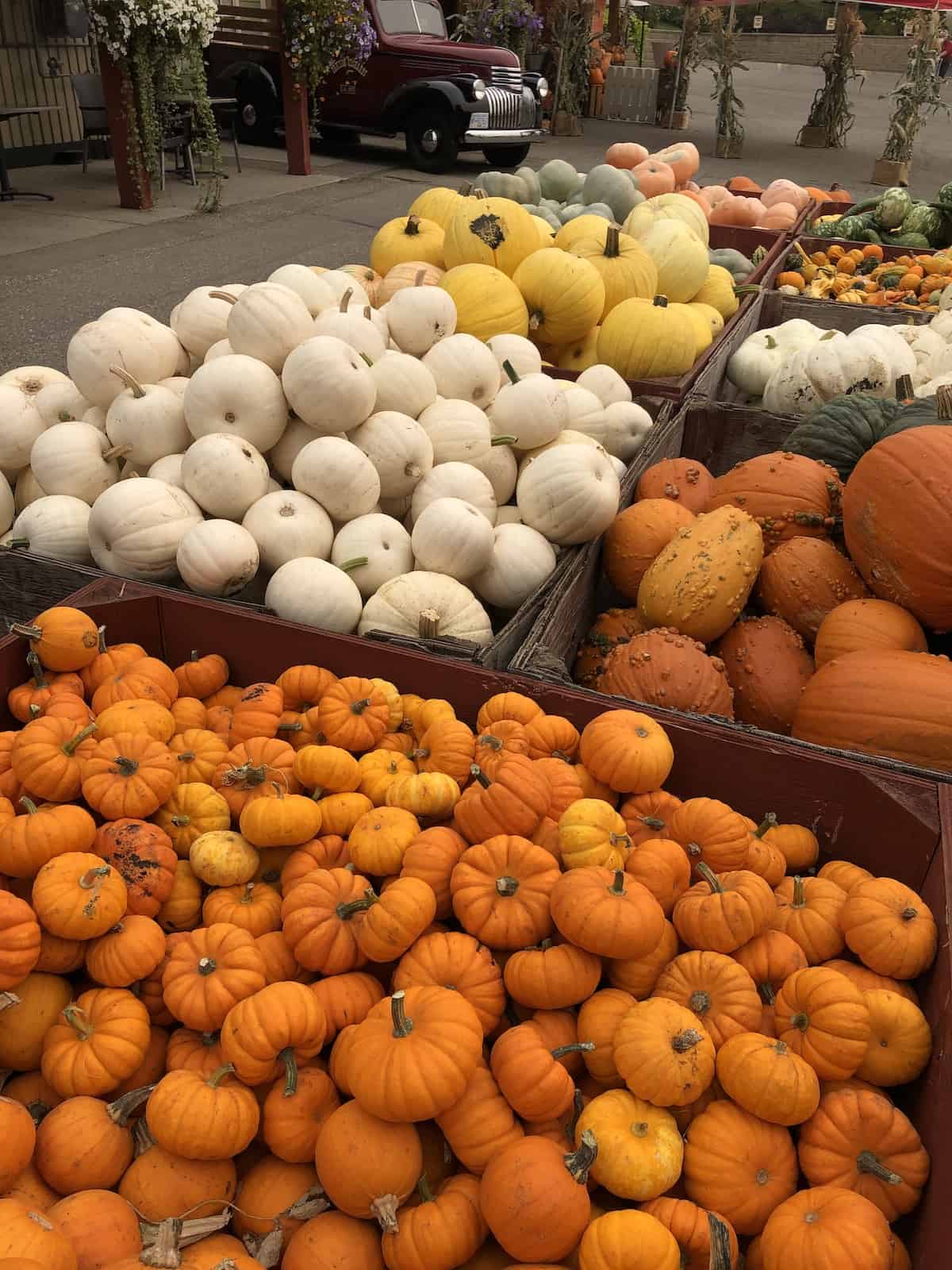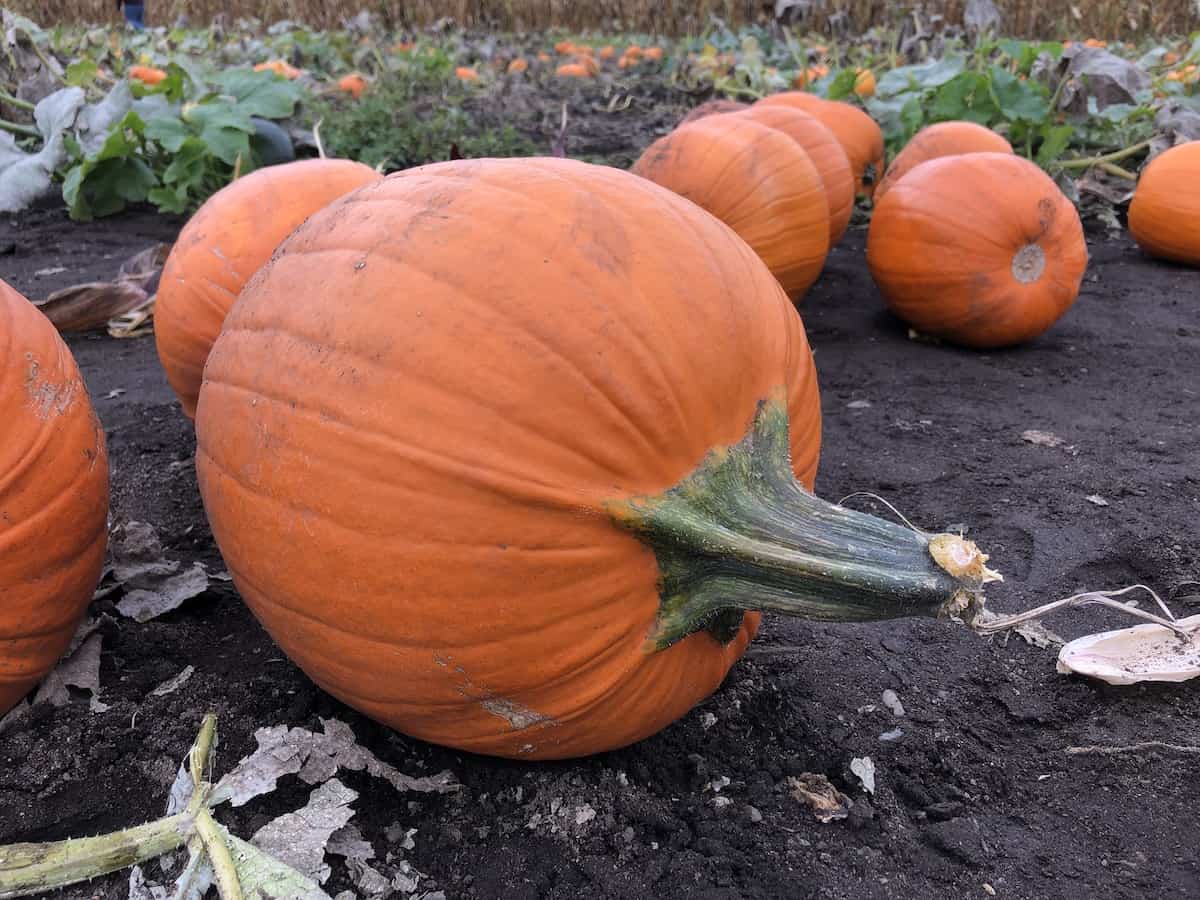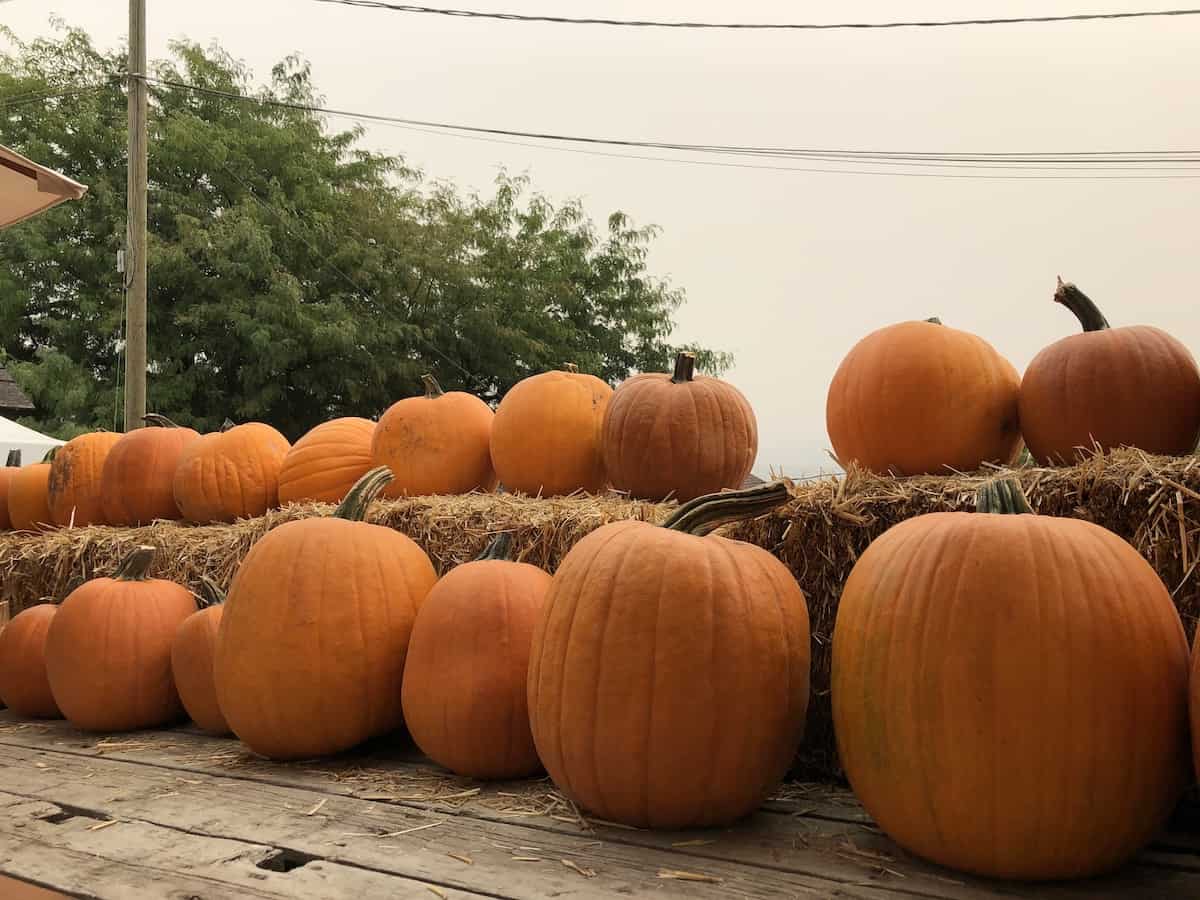Whole pumpkins generally last about 2-3 months in cool indoor storage conditions, although there are heirloom types that can last up to one year in storage! At room temperature, most pumpkins last only about a month.
Carved pumpkins have a much shorter shelf life. Carved Jack-O-Lanterns placed on a chilly front porch will usually last between 1 and 2 weeks, while a carved pumpkin lasts only a few days at room temperature. Carved pumpkins last longer if cut surfaces are kept clean and sprayed with a sealant.

The basics for long-lasting pumpkins
Here are the basics for the longest-lasting pumpkins:
- Look for heirloom culinary varieties like pie pumpkins bred for storage
- Choose pumpkins with intact rinds free from blemishes
- Cure the pumpkin rind at room temperature to create a barrier
- Place on a dry wooden board in the pantry or basement
- Store pumpkins at 50°-55°F (10°-13°C), and certainly no lower than 40°F (5°C)
- Carve Halloween pumpkins within a week of display (preferably several days)
- Keep cut surfaces clean, and consider using a sealant like polyurethane spray
Pumpkin harvest season
Pumpkin harvest generally occurs in late September to early October. Pumpkins are grown only during the warmer months and are harvested before the first frost. Most growers bring in their pumpkins before outdoor overnight temperatures drop below 40°F (5°C). Pumpkins left outdoors during a frost or in freezing temperatures will start to rot almost immediately.
In warm autumn weather, the outer rind of a pumpkin will start to harden on the vine. After harvest, the pumpkin is sometimes then kept at around room temperature for several weeks to allow the skin to harden further. This process is called “curing”. After curing, a pumpkin can be placed into cool, dry storage or used as decor in a seasonal autumn display. Cured pumpkins last much longer in storage than pumpkins with a rind that is not allowed to cure.
Pumpkins are generally stored indoors at a storage temperature of 50°-55°F (10°-13°C). Keeping the pumpkin whole protects the pumpkin from foreign bacteria and bugs entering the inside of the gourd, leading to a faster rotting process. The intact rind is an important barrier that protects the pulp/flesh. Do not store whole pumpkins in the fridge, as most fridges are too cold (below 50° F).

Choose healthy, undamaged individual pumpkins
The first consideration in post-harvest lifespan is to choose the healthiest individual pumpkins. Healthy pumpkins will store much, much longer than diseased or damaged fruits.
For the longest lifespan, choose pumpkins that are fully grown/mature, firm, disease-free, undamaged, and free from bruising. Lopsided pumpkins are normal/fine but don’t expect a long life from pumpkins with soft spots or blemishes.
Take extra care not to damage the pumpkins while handling them. If you’re harvesting it yourself from your garden or a pumpkin patch, leave about 3″ of stem on the pumpkin. Use sharp and clean pruning shears. You’ll want to wear gloves if touching the pumpkin vines or stem (it’s prickly). Brush any dirt off the pumpkin using gloves. Be careful not to bruise or cut the pumpkin.
Avoid holding the pumpkin by the stem. Damaged pumpkins have a much shorter shelf life than intact pumpkins that still have their stems. If transporting the pumpkin (car, truck, wheelbarrow) gently secure it so it doesn’t roll around during transport.


Cure the pumpkin’s peel for the longest lifespan
For the longest shelf life, pumpkins are sometimes “cured” for storage. Curing is when pumpkins are held at a warm temperature for 10-20 days so that the rind can heal and harden further. While curing isn’t strictly necessary, it may help prolong the fruit shelf life (especially for slightly immature pumpkins). Curing is standard procedure for pie pumpkins.
Harvested pumpkins are placed in a warm, dry, airy location to harden up their peel/skin. Pumpkins cure best around 80°-85°F (25°-30°C), but lower temperatures will do as long as there is some heat, good air circulation, and little wetness. Once cured, the outside peel of the pumpkin should be hard enough that your fingernail doesn’t easily dent or puncture it.

Choose “good keeper” varieties
Some varieties of pumpkin last much longer than other varieties. If you’re growing your own pumpkins or choosing from a specialty retailer, look for a variety that is known as a “good keeper” or “stores for months”.
These are generally old-fashioned cooking pumpkins that were grown to be stored through the winter for food. They tend to have thicker skins than pumpkins that are easily carved into Jack-O-Lanterns.
Estimated maximum pumpkin storage shelf life
How long do pumpkins last uncarved? It depends on the variety and when you bought them in the season. However, here is a general list of the estimated maximum storage shelf life for some specific pumpkin varieties:
- Connecticut Field Pumpkin: 2-3 Months
- Howden Commercial Pumpkin: 2-3 Months
- New England Sugar Pie Pumpkin: 2-3 Months
- Blue Doll Pumpkin: 3-6 Months
- Porcelain Doll Pumpkins: 4 Months
- Dickinson Culinary Pumpkin: 5 Months
- Jaune Gros de Paris: 5 Months
- Winter Sweet Kabocha Squash: 5 Months
- Long Island Cheese Pumpkin: 6 Months
- Rouge Vif d’Etampes Pumpkin (Red Cinderella): 6 Months
- Black Futsu Squash: 6 Months
- Moranga Pink Pumpkins: 6 Months
- Sweet Meat Squash: 6 Months
- Queensland Blue Pumpkin: 6 Months
- Galeux d’Eysines Pumpkin: 6 Months
- Kogigu Japanese Pumpkin: 8 Months
- Baby Boo Mini Pumpkin: 9 Months
- Musquee de Provence: 9 Months
- Jarrahdale Pumpkin: 12 Months
- Marina d’Chioggia Pumpkin: 12 Months
- Traimble Pumpkin: 12 Months
- Seminole Pumpkin: 12 Months
Pumpkins should be healthy, unblemished, and stored in optimal conditions to reach the estimated maximum shelf-life storage duration.
“All pumpkins and hard-shelled winter squash may be stored at the end of the growing season for use well into the new year. For best results, store sound, well-cured fruit at 50 to 55°F in a 50 to 70% relative humidity. Length of storage life varies according to variety and type of squash or pumpkin.”
Storing Pumpkin and Winter Squash at Home, by N.S. Mansour, Oregon State University Extension

Store in a cool, dry place
Store pumpkins in a cool, dry, breezy, dark place. Avoid hot and humid storage spots, as well as overly damp and cold basements and cellars. Moisture and stale air cause accelerated decay, as does exposure to hot temperatures and very cold temperatures.
A pumpkin left at room temperature in a dark place will last 1-3 months, depending on the type of pumpkin and the humidity of the room. Pumpkins last longer when the storage area is kept at a cool (but not cold) temperature. For the longest-lasting pumpkins, store them indoors where the temperature consistently remains between 50°-55°F (10°-13°C).
Pumpkins should not be stored at temperatures below 45°F (7.5°C), as these cold temperatures can cause softening (leading to rot). Do not store pumpkins in the refrigerator. Whole or carved pumpkins that have accidentally frozen will begin to rot as soon as they thaw.
The only exception to this is canned pumpkins. A canned pumpkin that has been opened must be stored in a fridge and tightly concealed. Through refrigeration, it can still be used for 5 to 7 days.
Store pumpkins on a dry wooden board to keep them up off the floor of the basement or pantry. They can also be stored on plywood, corrugated cardboard, straw, or a breathable mat. Pumpkins should also be stored away from apples/pears, as they can cause early pumpkin rot. Tree fruits are generally better stored at cooler temperatures than pumpkins anyways.
Check stored pumpkins regularly
Check pumpkins often for soft spots or other signs of rotting. Look for mold and mildew, and be on the lookout for creepy crawlers and other pests. Remove any pumpkins that show signs of deterioration to protect those that remain in storage.

When to carve pumpkins for Halloween?
To have carved pumpkins for Halloween, the best time to buy pumpkins and carve them is within one week of Halloween night. In hot climates, it may make more sense to wait until a day or two before carving pumpkins into Jack-O-Lanterns.
There are, however, all manner of concoctions suggested online to extend the life of a carved pumpkin. Some carvers have used antibacterial and antifungal cleaning solutions to slow decay and may employ oils/petroleum products like floor wax and automotive lubricants as a barrier.
Here are some popular sealants for cut surfaces to help carved pumpkins last longer:
- Clear Polyurethane Spray
- WD-40
- Bleach (Chlorine Bleach)
- Petroleum Jelly (Vaseline)
- Vegetable Oil (Olive Oil)
If you do choose to try and preserve your carved pumpkin with a chemical disinfectant or sealant, be sure to closely follow the manufacturer’s instructions and take the necessary safety precautions when working with chemicals.
“Pumpkin carvings will not last long. I have tried pickling them, treating them with fungicide, covering them in lemon juice, smothering them with petroleum jelly, and putting a finish on them. My best results have come from spraying the cut surface with a polyacrylic finish. This will prevent the pumpkin from drying out so fast and will extend the life of the carving. When spraying a carving with finish, be sure to do it outside or in a well-ventilated area. Dry the surface of the pumpkin with a cloth or paper towel before applying the finish.”
Preserving Pumpkins, Extreme Pumpkin Carving, by Vic Hood & Jack A. Williams
When do carved pumpkins go moldy?
Carved pumpkins generally go moldy within a week or two of carving. If you are going for the “rotted pumpkin” look for your Halloween season decor, the pumpkin generally has to be carved at least 2 weeks prior to Halloween. Cooler climates like the northern states and Canada may have to carve pumpkins in the first week of October to have a scary moldy mess by the time Halloween night arrives.
If you’d like to keep your pumpkin for a few days after illuminating it, try using flameless candles. LED candles are less likely to heat up the pumpkin’s flesh and accelerate the rotting process.

Resources
- Heirloom Pumpkin Varieties
- Decorative Pumpkin Varieties
- Mini Pumpkin Varieties
- How To Grow Organic Pumpkins
- Small Pumpkin Varieties









